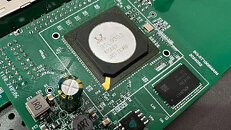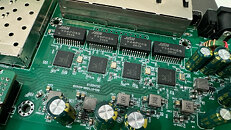TheLostSwede
News Editor
- Joined
- Nov 11, 2004
- Messages
- 18,469 (2.47/day)
- Location
- Sweden
| System Name | Overlord Mk MLI |
|---|---|
| Processor | AMD Ryzen 7 7800X3D |
| Motherboard | Gigabyte X670E Aorus Master |
| Cooling | Noctua NH-D15 SE with offsets |
| Memory | 32GB Team T-Create Expert DDR5 6000 MHz @ CL30-34-34-68 |
| Video Card(s) | Gainward GeForce RTX 4080 Phantom GS |
| Storage | 1TB Solidigm P44 Pro, 2 TB Corsair MP600 Pro, 2TB Kingston KC3000 |
| Display(s) | Acer XV272K LVbmiipruzx 4K@160Hz |
| Case | Fractal Design Torrent Compact |
| Audio Device(s) | Corsair Virtuoso SE |
| Power Supply | be quiet! Pure Power 12 M 850 W |
| Mouse | Logitech G502 Lightspeed |
| Keyboard | Corsair K70 Max |
| Software | Windows 10 Pro |
| Benchmark Scores | https://valid.x86.fr/yfsd9w |
At Computex, Realtek was showing off a new 5 Gbps switch platform which is set to bring much more affordable high-speed Ethernet switches to the consumer market. At the core of the new switch platform sits Realtek's RTL9303 which is an eight port 10 Gbps switch controller. This was released a few years ago as a low cost 10 Gbps switch IC, but as it still required third party PHYs, it never really took off. The RTL9303 is built around an 800 MHz MIPS 34Kc CPU and supports up to 1 GB of DDR3 RAM as well as 64 MB of SPI NOR Flash for the firmware.
When combined with Realtek's RTL8251B 5 Gbps PHY, the end result is a comparably low-cost 5 Gbps switch. According to Ananadtech, Realtek is expecting a US$25 price per port, which is only about $10 more per port than your typical 2.5 Gbps switch today, even though some are as little as US$10 per port. When combined with a Realtek RTL8126 PCIe based 5 Gbps NIC which retails from around US$30, 5 Gbps Ethernet looks like a very sensible option in terms of price/performance. Admittedly 2.5 Gbps Ethernet cards can be had for as little as $13, but they started out at a higher price point compared to what 5 Gbps NICs are already selling for. Meanwhile, 10 Gbps NICs are still stuck at around US$80-90, with switches in most cases costing at least US$45 per port, but often a lot more. 5 Gbps Ethernet also has the advantage of being able to operate on CAT 5e cabling at up to 60 metres and CAT 6 cabling at up 100 metres, which means there's no need to replace older cabling to benefit from it.


View at TechPowerUp Main Site | Source
When combined with Realtek's RTL8251B 5 Gbps PHY, the end result is a comparably low-cost 5 Gbps switch. According to Ananadtech, Realtek is expecting a US$25 price per port, which is only about $10 more per port than your typical 2.5 Gbps switch today, even though some are as little as US$10 per port. When combined with a Realtek RTL8126 PCIe based 5 Gbps NIC which retails from around US$30, 5 Gbps Ethernet looks like a very sensible option in terms of price/performance. Admittedly 2.5 Gbps Ethernet cards can be had for as little as $13, but they started out at a higher price point compared to what 5 Gbps NICs are already selling for. Meanwhile, 10 Gbps NICs are still stuck at around US$80-90, with switches in most cases costing at least US$45 per port, but often a lot more. 5 Gbps Ethernet also has the advantage of being able to operate on CAT 5e cabling at up to 60 metres and CAT 6 cabling at up 100 metres, which means there's no need to replace older cabling to benefit from it.


View at TechPowerUp Main Site | Source









